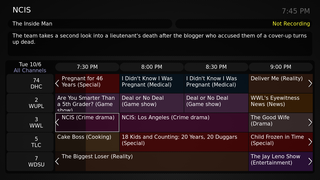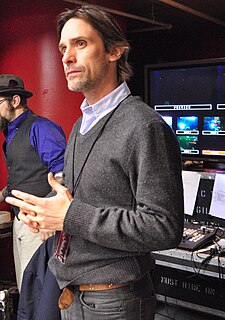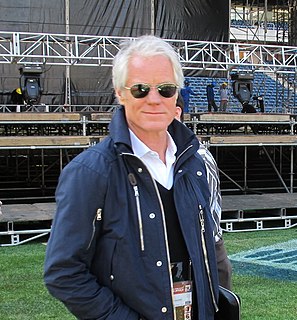
Streaming media is multimedia that is delivered and consumed in a continuous manner from a source, with little or no intermediate storage in network elements. Streaming refers to the delivery method of content, rather than the content itself.

Video on demand (VOD) is a media distribution system that allows users to access videos without a traditional video playback device and the constraints of a typical static broadcasting schedule. In the 20th century, broadcasting in the form of over-the-air programming was the most common form of media distribution. As Internet and IPTV technologies continued to develop in the 1990s, consumers began to gravitate towards non-traditional modes of content consumption, which culminated in the arrival of VOD on televisions and personal computers.

Interactive television is a form of media convergence, adding data services to traditional television technology. Throughout its history, these have included on-demand delivery of content, as well as new uses such as online shopping, banking, and so forth. Interactive TV is a concrete example of how new information technology can be integrated vertically rather than laterally.

A webcast is a media presentation distributed over the Internet using streaming media technology to distribute a single content source to many simultaneous listeners/viewers. A webcast may either be distributed live or on demand. Essentially, webcasting is "broadcasting" over the Internet.

A home theater PC (HTPC) or media center computer is a convergent device that combines some or all the capabilities of a personal computer with a software application that supports video, photo, audio playback, and sometimes video recording functionality. In recent years, other types of consumer electronics, including game consoles and dedicated media devices, have crossed over to manage video and music content. The term "media center" also refers to specialized application software designed to run on standard personal computers.
Streaming television is the digital distribution of television content, such as TV shows, as streaming media delivered over the Internet. Streaming TV stands in contrast to dedicated terrestrial television delivered by over-the-air aerial systems, cable television, and/or satellite television systems. The use of streaming online video and streaming television is concentrated on streaming video on demand platforms such as Netflix, Tubi, Crackle, Hulu, Amazon Prime Video, HBO Max, Vudu, Showmax, Peacock, Disney+, Apple TV+, BET+, and Paramount+.

Internet Protocol television (IPTV) is the delivery of television content over Internet Protocol (IP) networks. This is in contrast to delivery through traditional terrestrial, satellite, and cable television formats. Unlike downloaded media, IPTV offers the ability to stream the source media continuously. As a result, a client media player can begin playing the content almost immediately. This is known as streaming media.

Electronic programming guides (EPGs) and interactive programming guides (IPGs) are menu-based systems that provide users of television, radio and other media applications with continuously updated menus that display scheduling information for current and upcoming broadcast programming. Some guides also feature backward scrolling to promote their catch up content. They are commonly known as guides or TV guides.

Digital signage is a segment of electronic signage. Digital displays use technologies such as LCD, LED, projection and e-paper to display digital images, video, web pages, weather data, restaurant menus, or text. They can be found in public spaces, transportation systems, museums, stadiums, retail stores, hotels, restaurants and corporate buildings etc., to provide wayfinding, exhibitions, marketing and outdoor advertising. They are used as a network of electronic displays that are centrally managed and individually addressable for the display of text, animated or video messages for advertising, information, entertainment and merchandising to targeted audiences.
Roku, Inc. is an American publicly traded company based in San Jose, California, that manufactures a variety of digital media players for video streaming. Roku has an advertising business and also licenses its hardware and software to other companies.

Marc Scarpa is an American entrepreneur, producer and director specializing in live participatory media. He is an executive board member and the founding New York Chair of the Producers Guild of America New Media Council and a recipient of the Marc A. Levey distinguished service award. Scarpa has received a Webby Award in 2010 for Best Event / Live Webcast for his work on the 52nd Annual Grammy Awards, a Cannes Bronze Lion for Branded Content and Entertainment for the X Factor Pepsi Digital Preshow and Xtra Factor App and four Social TV Awards including Best of Show for X Factor Pepsi Digital Preshow and Xtra Factor App. Additionally, he has been a panelist for conferences such as NATPE, X-Summit, LTE North America, Digital Hollywood and Canadian Music Week among others.
Internet video is the general field that deals with the transmission of digital video over the internet. Internet video exists in several formats, the most notable being MPEG-4i AVC, AVCHD, FLV, and MP3.

A digital media player is a type of consumer electronics device designed for the storage, playback, or viewing of digital media content. They are typically designed to be integrated into a home cinema configuration, and attached to a television and/or AV receiver.

Kevin Wall, is an American media entrepreneur, global event producer, investor and activist. He is the CEO and founder of the investment fund PTK Capital, the co-founder and co-chairman of Dreamscape Immersive, a location-based virtual reality start up, and the founder and CEO of Control Room, a Los Angeles-based production company. The first person to receive an Emmy Award for interactive content, Wall is noted for his role in the development and adoption of media technologies including online and multi-platform distribution and media practices such as international rights acquisition and licensing.
Civolution is a provider of technology and services for identifying, managing and monetizing audio and video media content. The company offers a portfolio of proprietary and patented digital watermarking and digital audio and video fingerprinting technology for media protection: forensic tracking of media assets in pre-release, digital cinema, Pay Television and online; media intelligence: audience measurement, broadcast monitoring, internet and radio tracking; media interaction: automatic content recognition and triggering for second screen and connected television.
A smart TV, also known as a connected TV (CTV), is a traditional television set with integrated Internet and interactive Web 2.0 features, which allows users to stream music and videos, browse the internet, and view photos. Smart TVs are a technological convergence of computers, televisions, and digital media players. Besides the traditional functions of television sets provided through traditional broadcasting media, these devices can provide access to over-the-top media services such as streaming television and internet radio, along with home networking access.
Alan Saperstein is an American Internet entrepreneur in the video and digital media field. He is recognized for his accomplishments in the streaming media field as the first person to broadcast video on the Internet in a commercial application with a product called Hotelview in 1993. Saperstein is the Co-Founder of Visual Data Corporation, now called Onstream Media Corporation.

Screen-Smart Device Interaction (SSI) is fairly new technology developed as a sub-branch of Digital Signage.
BroadbandTV Corporation is a Canadian media and technology company founded by CEO Shahrzad Rafati in 2005. The company is the second largest video property by unique viewers across the top 12 countries in the world, according to comScore, with head office in Vancouver, British Columbia, Canada.
Automatic content recognition (ACR) is a technology to identify content played on a media device or present within a media file. Devices implementing ACR can allow the device or its manufacturer to collect content consumption information automatically "at the screen level" without any user-based input or search effort. This information may be collected for purposes such as personalized advertising, content recommendation, or for sale to customer data aggregators, and for other applications.